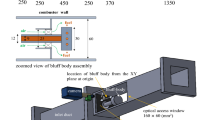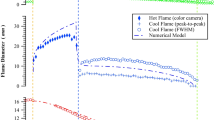Abstract
Propagation of a planar laminar flame in rich homogeneous propane–air and hydrogen–propane–air mixtures is numerically studied. It is shown that the maximum burning temperature is higher than the thermodynamically equilibrium value and is reached when chemical and physical processes have not been yet completed. The degree of superadiabaticity depends on the ratio of hydrogen and propane concentrations. Superadiabaticity in rich hydrogen–propane–air mixtures, in addition to the inhibiting action of propane, determines the deviation from Le Chatelier's principle for flammability limits in these mixtures.
Similar content being viewed by others
REFERENCES
V. V. Azatyan, Yu. N. Shebeko, I. A. Bolodian, and S. N. Kopylov, “Flammability limits of H2–C3H8 air mixtures at elevated pressures,” in: Abstracts of the 3rd Int. Seminar on Fire and Explosion Hazards (Winder-mere, Lake District, UK, April 10–14, (2000), Univ. of Central Lancashire, Preston (2000), p. 19.
I. Wierzba, G. A. Karim, H. Cheng, and M. Hanna, “The ammability of rich mixtures of hydrogen and ethylene in air,” J. Inst. Energy, March, 3–7 (1987).
V. V. Zamashchikov and V. A. Bunev, “Estimation of the efficiency of inhibitors acting on combustion of gases,” Combust. Expl. Shock Waves, 37, No. 4, 378– 386 (2001).
A. I. Rozlovskii, Fundamentals of Explosion-Safety En-gineering in Operating Combustible Gases and Vapors [in Russian], Khimiya, Moscow (1980).
A. I. Rozlovskii, “Thermal regime of combustion of rich carbon-containing mixtures with a subcritical compo-sition,” Dokl. Akad. Nauk SSSR, 186, No. 2, 373–376 (1969).
F. Lui, H. Guo, G. Smallwood, and O. Gulder, “Nu-merical study of the super-adiabatic ame temperature phenomenon in hydrocarbon premix ames,” in: Ab-stracts of the 29th Int. Symp. on Combustion (2002), p. 12.
G. Tsatsaronis, “Prediction of propagation laminar ames in methane, oxygen, nitrogen mixtures,” Com-bust. Flame, 33, 217 (1978).
K. Seshadri, X. S. Bai, and H. Pitsch, “Asymptotic structure of rich methane-air ames,” Combust. Flame, 127, 2265–2277 (2002).
R. J. Kee, J. F. Grcar, M. D. Smooke, and J. A. Miller, “PREMIX,” Report No. SAND85-8240, Sandia Nat. Lab. (1985).
R. J. Kee, F. M. Rupley, and J. A. Miller, “CHEMKIN-II: A Fortran Chemical Kinetics Package for the Analysis of Gas Phase Chemical Kinetics,” Report No. SAND89-8009B, Sandia Nat. Lab. (1989).
A. A. Konnov, “Detailed reaction mechanism for small hydrocarbons combustion. Release 0.5,” http://homepages.vub.ac.be/ ¢ akonnov/.
S. Okajima, K. Iinuma, S. Yamaguchi, and S. Kumagai, “Measurement of slow burning velocities and their pressure dependence using a zero-gravity method,” in: Proc. of the 20th Int. Symp. on Combustion, The Combustion Inst., Pittsburgh (1984), pp. 1951–1956.
V. N. Krivulin, E. A. Kudryavtsev, A. N. Baratov, et al., “A study of combustion limits in large volumes. II. Propane–air mixtures,” Combust. Expl. Shock Waves, 14, No. 6, 701–704 (1978).
J. M. Singer and J. Grumer, “Carbon formation in very rich hydrocarbon–air ames. I. Studies of chemical content, temperature, ionization and particulate matter,” in: Proc. of the 7th Int. Symp. on Combustion, The Combustion Inst., London (1959), pp. 559–569.
A. N. Baratov and A. Ya. Korol'chenko (eds.), Fire and Explosion Safety of Substances and Materials and Means for Their Extinguishing [in Russian], Khimiya, Moscow (1990).
Author information
Authors and Affiliations
Rights and permissions
About this article
Cite this article
Zamashchikov, V.V., Namyatov, I.G. & Bunev, V.A. Specific Features of the Mechanism of Flame Propagation in Rich Hydrogen–Propane–Air Mixtures. Combustion, Explosion, and Shock Waves 40, 524–534 (2004). https://doi.org/10.1023/B:CESW.0000041404.38347.06
Issue Date:
DOI: https://doi.org/10.1023/B:CESW.0000041404.38347.06




